"Ring Around the Rosie" was likely created as a children's singing game in 18th-century Germany — but some people believe it has much darker origins.
“Ring around the rosie, pocket full of posies. Ashes! Ashes! We all fall down!” It’s a classic nursery rhyme that children often sing on the playground while spinning around. “Ring Around the Rosie,” or “Ring a Ring o’ Roses,” as it is sometimes known, is a lighthearted, playful tune from childhood.
But some people believe it has a much darker background. Since the mid-20th century, theorists have drawn a connection between the rhyme and the Great Plague of London, an outbreak of the bubonic plague that hit the city in 1665.
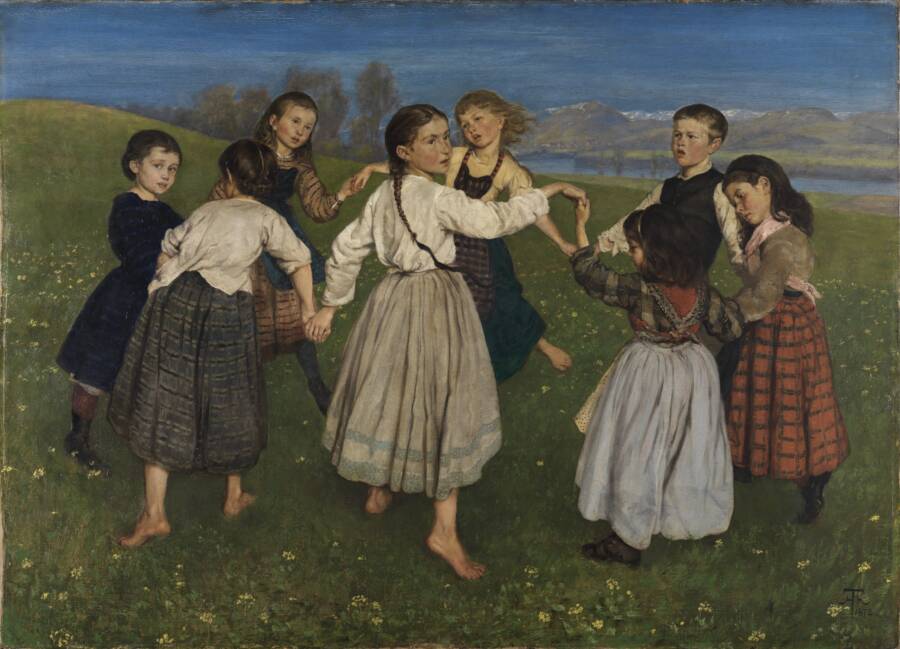
Public DomainThe painting Kinderreigen (Children’s Dance) by Hans Thoma. 1872.
However, there is no concrete evidence to suggest this is true. For starters, there are many versions of “Ring Around the Rosie,” all with different lyrics. Furthermore, there are several conflicting stories about where the rhyme originated.
This dark rumor about “Ring Around the Rosie” has been classified as folklore. However, the true story behind the rhyme is perhaps more interesting than this pervasive myth.
The Allegedly Dark History Behind ‘Ring Around The Rosie’
According to many sources, including James FitzGerald of the Londonist, “Ring Around the Rosie” refers to the Great Plague, and the harmless nature of the rhyme serves as “a foil for one of London’s most atavistic dreads.”
The rhyme as quoted by FitzGerald reads:
“Ring-a-ring-a-roses,
A pocket full of posies,
A-tishoo! A-tishoo!
We all fall down.”
FitzGerald and others have cited the roses in the song as a euphemism for the deadly, ringed rashes caused by the bubonic plague. The posies — one of the few consistencies across versions of the rhyme — were bunches of plants people carried around as a supposed preventative measure. “A-tishoo” refers to sneezing. And everyone falling down suggests death.
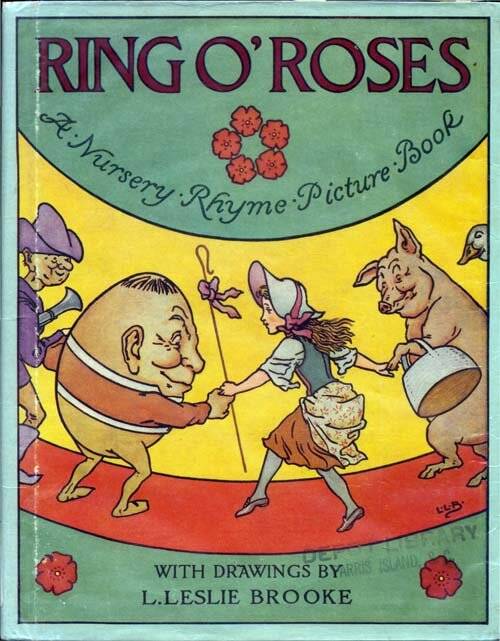
Public DomainThe cover of Ring O’ Roses by L. Leslie Brooke.
The more common “Ashes! Ashes!” version of the song is often associated with cremating the dead. And while FitzGerald claims the rhyme was about the Great Plague, others have traced the reference back even further to the Black Death of 14th-century England. But that doesn’t quite make sense either because, as the Natural History Museum acknowledges, cremation was banned in England after the end of Roman rule, and it was not made legal until the 1880s.
It is these inconsistencies that cast the first stones of doubt at the meaning of “Ring Around the Rosie.” If the song truly were a reference to the Great Plague or the Black Death, why would the details not remain consistent? This explanation only gets muddier when other versions of the song are considered, many of which don’t feature any dark allusions to death, such as:
“A ring, a ring o’ roses
A pocket full of posies
One for Jack and one for Jim and one for little Moses
A curchey in and a curchey out
And a curchey all together”
Often, children playing the game race to curtsy, stoop, or fall. In various versions, whoever is the last to do so may have to stand in the center of the circle or even confess who their crush is.
As folklorist Stephen Winick wrote in a 2014 blog for the Library of Congress, “In many versions, then, the roses and posies signify what flowers often signify in traditional European culture: not suffering and death, but joy and love.”
So, if the meaning of “Ring Around the Rosie” isn’t actually death, why did the theory become so widespread?
How The Nursery Rhyme Became Associated With The Plague
Depending on which plague the nursery rhyme allegedly alludes to — either the Black Death or the Great Plague — one thing in particular creates some skepticism about this interpretation. The earliest print appearance of “Ring Around the Rosie” in English was in Kate Greenaway’s Mother Goose or The Old Nursery Rhymes in 1881.
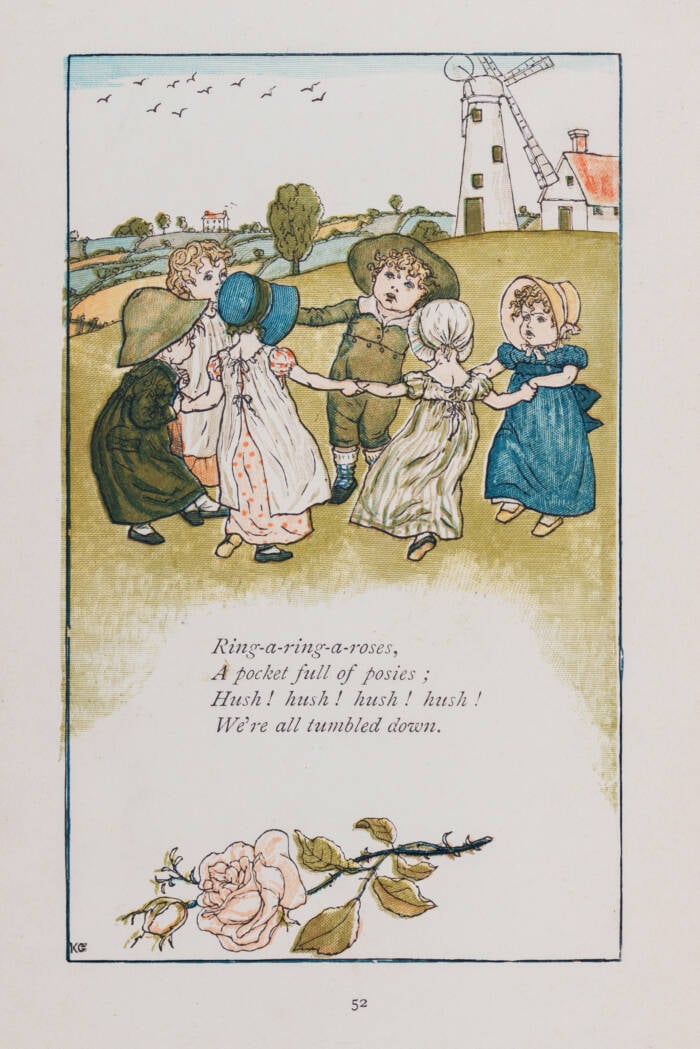
Cover to Cover / Alamy Stock PhotoThe first English printing of “Ring Around the Rosie” in the illustrated Mother Goose by Kate Greenaway published in 1881.
Of course, nursery rhymes and other forms of folklore were often passed along orally long before they were ever put into print, but as Snopes points out, this would mean some variation of “Ring Around the Rosie” was being repeated for up to five centuries before its printing.
This would make the rhyme older than The Canterbury Tales — so why aren’t there Middle English versions of the song?
Even within a decade after Greenaway’s Mother Goose, several variations of “Ring Around the Rosie” were printed in folklore collections. In fact, in 1883, two versions of the rhyme appeared in the works of William Wells Newell as such:
“Ring a ring a rosie,
A bottle full of posie,
All the girls in our town
Ring for little Josie.Round the ring of roses,
Pots full of posies,
The one stoops the last
Shall tell whom she loves the best.”
Once again, these variations of the nursery rhyme have no allusion or reference to any sort of plague. It wasn’t until 1961, in fact, that this connection was even made for the first time.
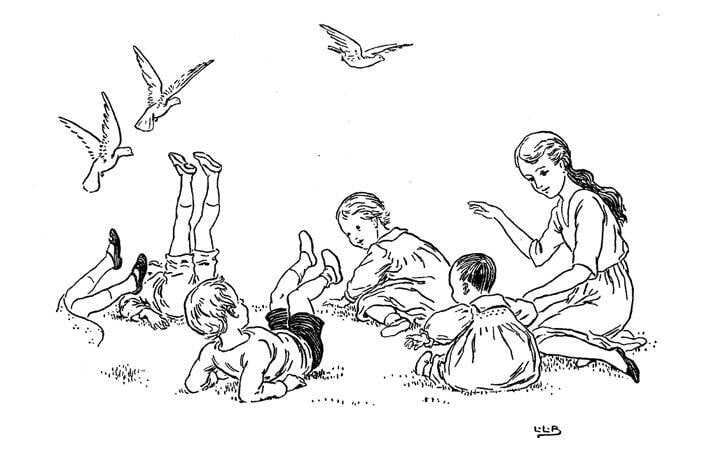
Public DomainAn illustration by L. Leslie Brooke for “All Tumble Down” from the 1922 book Ring O’ Roses.
It was James Leasor’s The Plague and the Fire in 1961 that first drew a connection between “Ring Around the Rosie” and any sort of plague — 80 years after the nursery rhyme appeared in print.
“Few people watching a group of children dancing hand-in-hand in a circle to this well-known nursery rhyme may realize that it has its origin in the plague,” Leasor wrote. “Roses refer to the rosy rash of plague, ringed to signify the tokens; the poesies were herbs and spices carried to sweeten the air; sneezing was a common symptom of those close to death. The words ‘we all fall down’ certainly referred to Londoners during that stifling August.”
However, it is more likely that there is a far simpler explanation as to why children played and sang “Ring Around the Rosie” — and it has nothing to do with a plague.
The Real Reason Children Sang ‘Ring Around The Rosie’
The simplest explanation behind “Ring Around the Rosie” comes from folklorist Philip Hiscock, who examined the historical context of the late 19th and early 20th centuries to search for an answer.
“The more likely explanation is to be found in the religious ban on dancing among many Protestants in the 19th century, in Britain as well as here in North America,” he said. “Adolescents found a way around the dancing ban with what was called in the United States the ‘play-party.'”
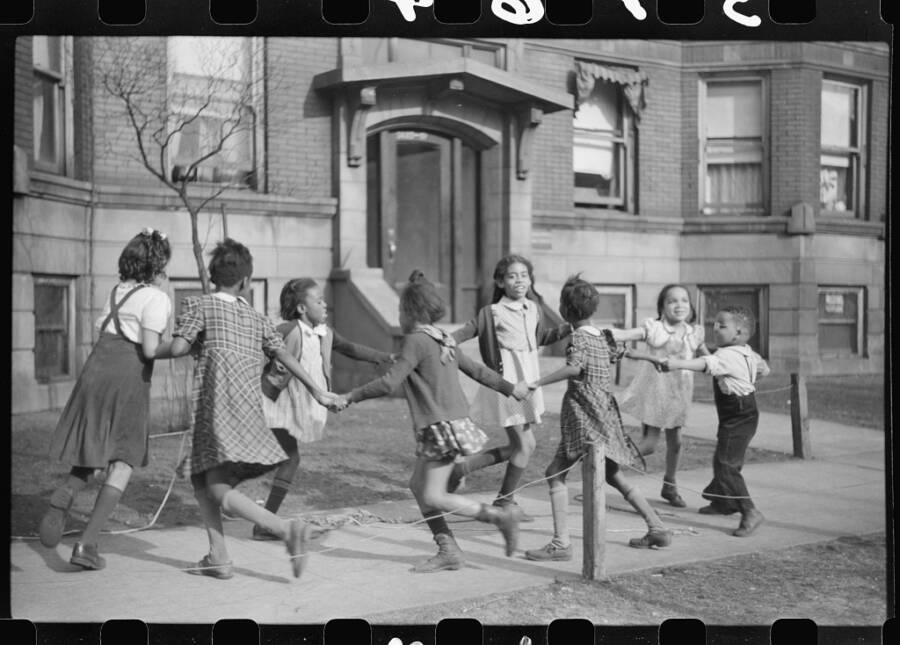
Library of CongressA group of children playing “Ring Around the Rosie” in Chicago. April 1941.
According to Hiscock, play parties were essentially square dances, only lacking any musical accompaniment. They were immensely popular among adolescents, and eventually, nursery games took on the same traits.
As for the meaning of “Ring Around the Rosie,” there may not be one at all. The Beatles, for example, often wrote nonsensical lyrics that they thought sounded good — to which meaning was later applied by fans and critics alike. When something lyrical is vague enough, just about any meaning can be attributed to it.
In fact, the truth is far less bleak and dark. No, “Ring Around the Rosie” is not about a plague; it is just a fun rhyme for children to sing.
After learning about the true story behind “Ring Around the Rosie,” explore the allegedly grisly meaning behind “London Bridge is Falling Down.” Or, dive into the dark stories behind these seven popular nursery rhymes.





